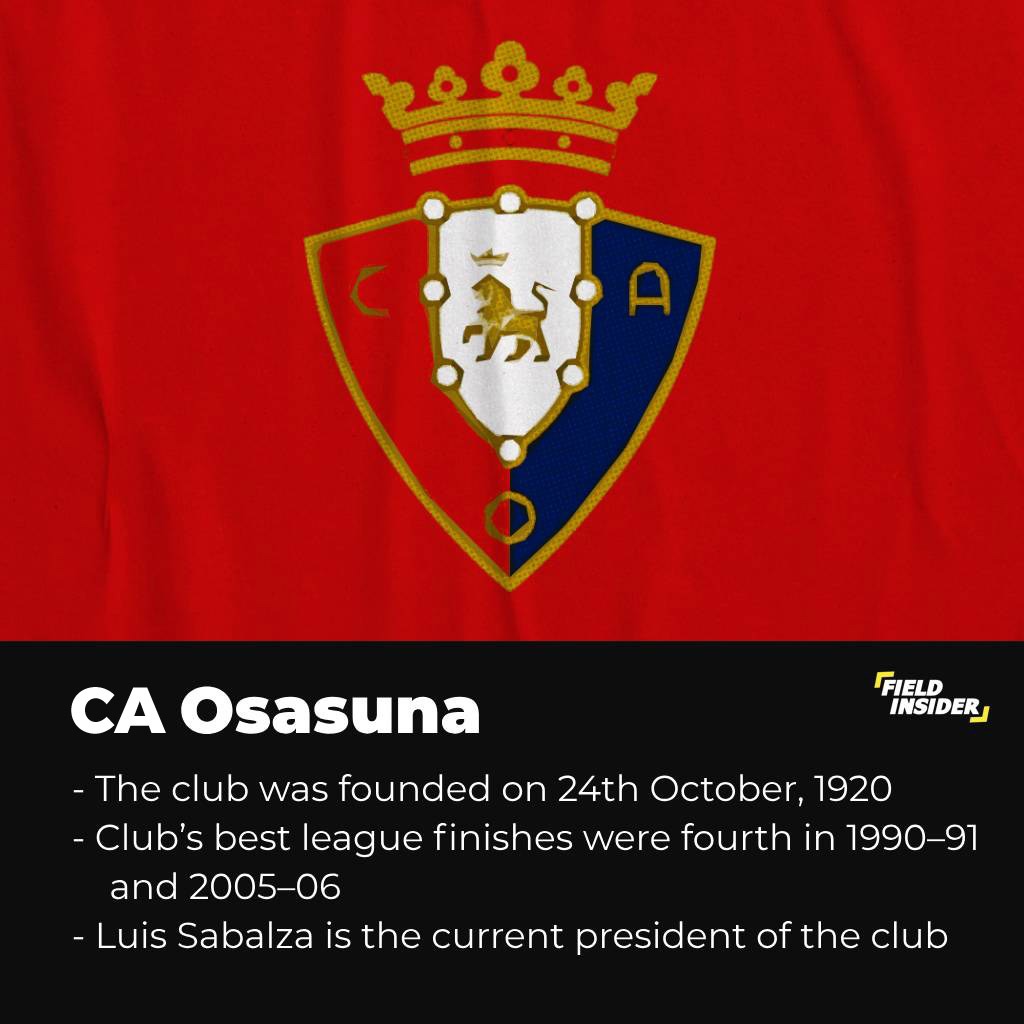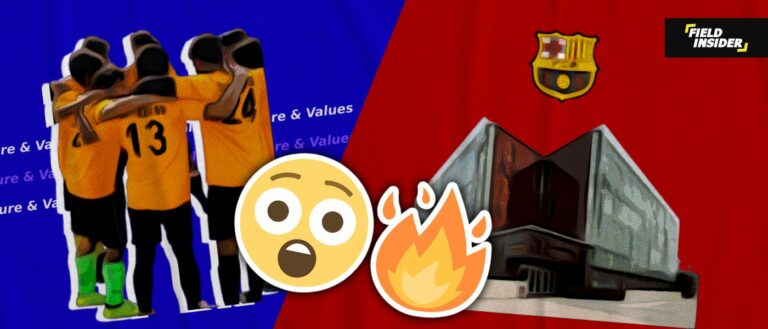Who Are CA Osasuna? History, Stats & More
Meet Club Atlético Osasuna, the beating heart of Pamplona, Navarre. Founded in 1920, this Spanish football powerhouse graces La Liga, dominating at El Sadar Stadium. Adorned in red jerseys with navy blue shorts, “Los Rojillos” aims high.
Owned by its members, Osasuna’s trophy quest led to the Copa del Rey finals in 2005 and 2023. Their Basque name, “Osasuna”, meaning “health” in Basque, signifies unwavering strength.
Rivalries ignite with Real Zaragoza, Real Madrid, and Athletic Bilbao. Osasuna’s Cantera cultivates talents, mirroring Basque excellence. Osasuna, a history-rich marvel, paints the football world with passion and glory. As Osasuna marches forward, its history, passion, and tenacity continue to inspire the football world. You can always head over to our soccer section and read about your favorite club!
Who Are Osasuna In La Liga?
Osasuna, the pride of Navarre, has etched its name in La Liga history. With notable league finishes, including a commendable fourth place in 1990–91 and 2005–06, they’ve consistently showcased their prowess. While national trophies elude them, Osasuna’s star shines brightly, having contested Copa del Rey finals in 2005 and 2023.
Their home ground, the 23,516-capacity El Sadar Stadium, roars with fervent supporters donning the iconic red shirt and navy blue shorts. As they tread the La Liga path, Osasuna’s aspirations soar higher.

History Of Osasuna
Foundation and Early Beginnings
On October 24, 1920, the foundation of Club Atlético Osasuna marked the beginning of a storied legacy. “Osasuna,” echoing “health” in Basque, was chosen as the club’s name by Benjamín Andoian Martnez.
The shift to professional Spanish football in 1928 placed Osasuna in the third division, but their ascent was swift. By triumphing over Nacional de Madrid in the 1931–32 playoff, they secured their place in the Segunda División. In a mere three seasons, Osasuna celebrated their elevation to La Liga.
Despite this, their journey was marred by turbulent Spanish history. The 1936 coup détat orchestrated by Nationalist rebels brought oppression. Tragedy struck as players, employees, and board members, numbering at least ten, faced imprisonment, persecution, or even death.
A pivotal moment arrived in September 1967, as Osasuna unveiled their El Sadar Stadium. This monumental occasion witnessed a decisive 3–0 victory over Vitoria de Setubal. From its inception, Osasuna’s path has been a testament to resilience, etching an indelible mark in football history.
Glory Days and the 1980s
In the vibrant 1980s, Osasuna’s ambitions soared. Their breakthrough arrived in 1985-86 when they secured a monumental UEFA Cup qualification by clinching the sixth spot in the league. Building on this momentum, a remarkable fourth-place league finish in 1990–91 set new standards.
Eager for more, Osasuna’s tenacity showed as they secured a coveted spot in the following season’s UEFA Cup. Despite challenges, including a last-place finish in 1993–94, the team demonstrated resilience during their six-year stint in the second tier. In 1999-2000, their triumphant return to the top flight was sealed with a second-place finish in the second-division league.
Notably, Osasuna’s 2002–03 Copa del Rey journey marked a resurgence, reaching the semi-finals for the first time since 1988. The spirited team’s ascent continued as they claimed their spot in the 2005 Copa del Rey final. Despite a valiant effort, they narrowly lost to Real Betis in extra time.
A significant milestone was etched on November 27, 2005, when Osasuna celebrated their 1,000th La Liga match. A spectacular 2005–06 domestic campaign saw them capture fourth place, equaling their best-ever league finish. This remarkable feat propelled them into the UEFA Champions League qualifying phase for the upcoming season, underlining their dedication to football excellence.
Nurturing Talent
At the heart of CA Osasuna’s success lies its thriving cantera. It is the club’s esteemed youth academy that is responsible for shaping future stars from their formative years to their integration into the senior squads.
The pinnacle of this development journey is the Juvenil A (Basque: Gazteak A) team, the under-18/19 unit that proudly represents the club on the national stage. Graduates of this program typically transition to either the affiliated CD Subiza (formerly CD Iruña) for younger talents or the reserve team, Osasuna B.
Both of these avenues are crucial steps within Cantera’s framework. They foster progression towards the senior team while competing in adult leagues.
Tajonar is the club’s dedicated training complex. It serves as the nurturing ground for these talents, who are at the center of the entire system. With an unwavering commitment to fostering emerging football stars, Osasuna’s Cantera is a cornerstone of their football legacy.
More Than Just Football
Osasuna Football Club is unlike any other. Amid the journey along the Camino de Santiago, this remarkable team is making hearts beat. The city has a vibrant energy of its own. The atmosphere is always electrifying as local bars overflow with pumped-up fans. Fans fill the jubilant streets after a win, and the celebration echoes their Basque name’s essence – ‘health’ – as a source of unity, resilience, and joy.
Osasuna: First Successes
Osasuna’s journey to prominence is marked by significant milestones. The club’s ascent to professional football in 1928 ushered them into the third division. A remarkable feat was achieved after the 1931–32 season when they secured promotion to the Segunda División, triumphing in a gripping playoff against Nacional de Madrid. In a mere three seasons, Osasuna entered La Liga’s prestigious stage
The club’s commendable campaign wasn’t confined to league accomplishments alone. Osasuna displayed their mettle in the Copa del Rey, reaching the semi-finals in successive seasons. Despite valiant efforts, they faced losses against Sevilla and Barcelona, respectively.
The historic year 1985–86 saw Osasuna clinch their first UEFA Cup qualification, a monumental stride. Bolstered by their success, they achieved a remarkable fourth-place finish in the 1990–91 league, paving their path to the UEFA Cup. This trend continued with an inspiring run to the 2002–03 Copa del Rey semi-finals and the coveted Copa del Rey final in 2005, albeit ending in defeat against Real Betis in extra time.
A watershed moment arrived again in the 2005–06 season. Displaying sheer brilliance, Osasuna secured an unprecedented fourth-place finish, propelling them into the UEFA Champions League qualifying phase. Their exceptional run in the 2006–07 UEFA Cup defied expectations, with a spirited journey to the semi-finals after finally being beaten by fellow La Liga team Sevilla.
Recent years have maintained Osasuna’s momentum, as they clinched a place in the UEFA Conference League through their 7th position in the 2023 La Liga, coupled with an impressive runner-up finish against Real Madrid in the Copa del Rey.
How Was The Club Founded?
On October 24, 1920, the seeds of Club Atlético Osasuna were sown. The club’s moniker, “Osasuna,” resonates with the Basque word for health, chosen thoughtfully by the visionary Benjamín Andoian Martínez. As the curtains rose on professional Spanish football in 1928, Osasuna’s journey commenced in the third division. Their ascendancy was swift, marked by a triumphant promotion to the Segunda División after a spirited playoff victory against Nacional de Madrid in the 1931–32 season. This early success set the stage for Osasuna’s enduring legacy in the realm of Spanish football.
Fans & Culture Of Osasuna :
Step into the realm of Osasuna fandom, and you’ll encounter a spirited community, unlike the usual Spanish football enthusiasts. These fans bear the distinct pride of being Navarros, deeply rooted in their Basque heritage. The fluttering Basque flags that grace their matches are a testament to this unwavering cultural allegiance.
Embracing their identity, these passionate supporters vehemently reject Spanish symbols, deeming them as affronts. The indomitable Indar Gorri, the club’s ‘ultras’, stand tall as advocates of anti-fascism and fervent proponents of Basque independence. Yet, paradoxically, their distaste for Athletic Bilbao, the Basque region’s juggernaut, is well-known due to player disputes.
Their rivalry extends to despising Real Madrid and holding an intense aversion to Real Zaragoza, their nearest major ‘Spanish’ counterpart. Dive into their world by immersing yourself in ‘No Hay Tregua’, an anthem by Navarre’s 80s rock legends ‘Barricada’, an ode not just to Osasuna but also to the counterculture of Pamplona and Navarre.
Beyond league conquests, Osasuna’s mettle shone in the Copa del Rey, reaching successive semi-finals against Sevilla and Barcelona. The historic milestone of the 1985–86 season marked their inaugural UEFA Cup qualification, a testament to their growing prowess. A dazzling fourth-place league finish in 1990–91 marked their passage to the UEFA Cup, followed by an inspiring run to the Copa del Rey final in 2005, albeit with a heartbreaking extra-time loss to Real Betis.

Achievements
The iconic 2005–06 season saw Osasuna soar to an unprecedented fourth-place league finish, propelling them into the UEFA Champions League qualifiers. Their remarkable journey in the 2006–07 UEFA Cup defied the odds, leading to a gallant semi-final showdown with fellow La Liga contenders Sevilla.
Recent years have sustained Osasuna’s momentum, securing a spot in the UEFA Conference League through their commendable 7th position in the 2023 La Liga. Their remarkable journey was further highlighted by a memorable runner-up feat against Real Madrid in the Copa del Rey.
Notable Players In The History Of The Club:
Osasuna’s history is adorned with memorable players who’ve given their sweat and blood to the club. Michael Robinson, Juanfran, John Aloisi, Cesar Azpilicueta, David Garcia, Roberto Torres, and Miguel Flano stand as revered names in the history books of Osasuna. Their contributions and dedication have significantly contributed to Osasuna’s journey of success.

Top Goal-Scorers In the History Of The Club:
| Name Of Players | No. Of Goals Scored |
| Roberto Torres | 60 |
| Jan Urban | 36 |
| John Aloisi | 32 |
| Javad Nekounam | 31 |
| Walter Pandiani | 31 |
Top Assist-Providers In The History Of CA OSASUNA:
| Name Of Players | No. Of Assists |
| Roberto Torres | 55 |
| Rubén García | 26 |
| Patxi Puñal | 22 |
| Kike Barja | 20 |
| Nino | 20 |
Players With The Most Appearances For Club:
| Name Of Players | No. Of Appearances |
| Patxi Puñal | 466 |
| Oier Sanjurjo | 356 |
| Roberto Torres | 353 |
| Miguel Flaño | 335 |
| César Cruchaga | 296 |
Most Expensive Transfers Of CA Osasuna:
| Name Of Player | Club From | Club To | Transfer Season | Transfer Cost |
| Ante Budimir | RCD Mallorca | CF Osasuna | 21/22 | €8 Million |
| Raúl García | Levante | CF Osasuna | 23/24 | €6.5 Million |
| Rubén García | Belenenses | CF Osasuna | 19/20 | €3.5 Million |
| Dady | Sharjah FC | CF Osasuna | 07/08 | €3.5 Million |
| Masoud Shojaei | Getafe | CF Osasuna | 08/09 | €3.5 Million |
Home Of Osasuna: El Sadar Stadium

Nestled in the heart of Pamplona, Navarre, the iconic Estadio El Sadar stands as the fortress of Osasuna. With a capacity of 23,516, it echoes with the thunderous cheers of passionate fans.
The stadium’s history dates back to 1967 when it first opened its gates for a clash between Real Zaragoza and Portugal’s Vitoria de Setúbal.
Once named Reyno de Navarra under sponsorship, it later returned to its original moniker, El Sadar, derived from a nearby river. A significant chapter unfolded in 2019 when the club’s supporters voted for an expansion, resulting in almost 24,000 seats and modern enhancements.
This rejuvenated arena remains a testament to Osasuna’s enduring spirit and the vibrant football culture it embodies.
Rivalries of Osasuna With Other Clubs:
Osasuna thrives in the fiery cauldron of rivalries, igniting passions on and off the field. The clash with Real Madrid ignited in 1990 when Osasuna triumphed 4–0 at Santiago Bernabéu Stadium. A different kind of heat sparks against Real Zaragoza, sparked by an incident in 1987 when Zaragoza fans targeted Osasuna’s goalkeeper.
What ensued was a fierce, hostile rivalry featuring altercations between fans and players, carving its name as one of Spain’s most intense rivalries. Yet, these rivalries aren’t constant flames; periods of absence in recent years marked when the clubs resided in different divisions. The rivalries stand as a testament to Osasuna’s unyielding spirit in the heat of competition.
Conclusion: What Lies Ahead For The Club?
As the dust settles on Osasuna’s storied journey, one thing remains certain: their future shines brightly. From their foundation in 1920 to their historic UEFA Cup qualifications, Osasuna’s unyielding spirit and indomitable determination have carved their place in football history.
The echoes of triumph resonate through their achievements, from Copa del Rey finals to gripping rivalries. As the club forges ahead, its unwavering support and vibrant culture fuel its ambitions. With a stadium that has witnessed legends and a youth academy nurturing talents, Osasuna’s path is set on a trajectory of success. With each challenge embraced, they march forward, united in their pursuit of greatness, as their fans’ fervor and Basque pride illuminate the road ahead.








